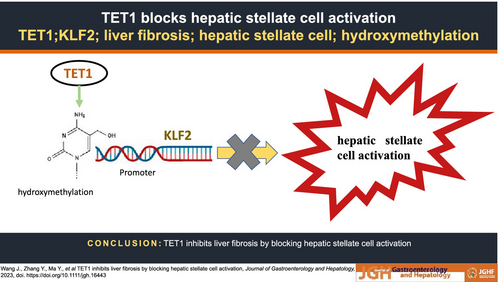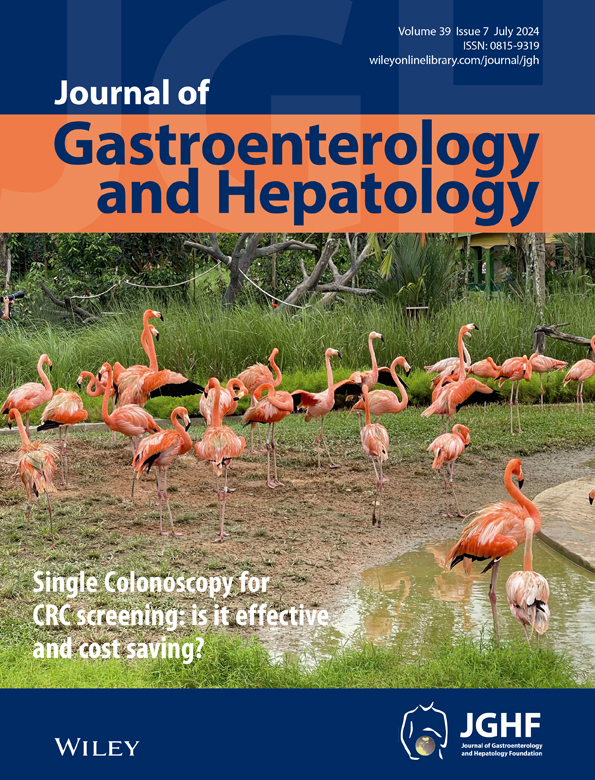TET1 inhibits liver fibrosis by blocking hepatic stellate cell activation
Jingjie Wang
Department of Gastroenterology, The First Affiliated Hospital, College of Medicine, Zhejiang University, Hangzhou, China
Department of Digestive Diseases, Huashan Hospital, Fudan University, Shanghai, China
Co-first author: Jingjie Wang, Yitong ZhangSearch for more papers by this authorYitong Zhang
Department of Digestive Diseases, Huashan Hospital, Fudan University, Shanghai, China
Co-first author: Jingjie Wang, Yitong ZhangSearch for more papers by this authorYanyun Ma
State Key Laboratory of Genetic Engineering, Human Phenome Institute, Fudan University, Shanghai, China
Department of Anthropology and Human Genetics, School of Life Sciences, Fudan University, Shanghai, China
Six-sector Industrial Research Institute, Fudan University, Shanghai, China
Search for more papers by this authorSuhan Zhao
Department of Digestive Diseases, Huashan Hospital, Fudan University, Shanghai, China
Search for more papers by this authorJiucun Wang
State Key Laboratory of Genetic Engineering, Human Phenome Institute, Fudan University, Shanghai, China
Department of Anthropology and Human Genetics, School of Life Sciences, Fudan University, Shanghai, China
Search for more papers by this authorCorresponding Author
Hongtan Chen
Department of Gastroenterology, The First Affiliated Hospital, College of Medicine, Zhejiang University, Hangzhou, China
Correspondence
Jie Liu, State Key Laboratory of Genetic Engineering, Human Phenome Institute, Fudan University, Shanghai 201203, China.
Email: [email protected]
Jun Zhang, Department of Digestive Diseases, Huashan Hospital, Fudan University, Shanghai 200040, China.
Email: [email protected]
Hongtan Chen, Department of Gastroenterology, The First Affiliated Hospital, College of Medicine, Zhejiang University, Hangzhou,310002, China.
Email: [email protected]
Search for more papers by this authorCorresponding Author
Jun Zhang
Department of Digestive Diseases, Huashan Hospital, Fudan University, Shanghai, China
Correspondence
Jie Liu, State Key Laboratory of Genetic Engineering, Human Phenome Institute, Fudan University, Shanghai 201203, China.
Email: [email protected]
Jun Zhang, Department of Digestive Diseases, Huashan Hospital, Fudan University, Shanghai 200040, China.
Email: [email protected]
Hongtan Chen, Department of Gastroenterology, The First Affiliated Hospital, College of Medicine, Zhejiang University, Hangzhou,310002, China.
Email: [email protected]
Search for more papers by this authorCorresponding Author
Jie Liu
Department of Digestive Diseases, Huashan Hospital, Fudan University, Shanghai, China
State Key Laboratory of Genetic Engineering, Human Phenome Institute, Fudan University, Shanghai, China
Correspondence
Jie Liu, State Key Laboratory of Genetic Engineering, Human Phenome Institute, Fudan University, Shanghai 201203, China.
Email: [email protected]
Jun Zhang, Department of Digestive Diseases, Huashan Hospital, Fudan University, Shanghai 200040, China.
Email: [email protected]
Hongtan Chen, Department of Gastroenterology, The First Affiliated Hospital, College of Medicine, Zhejiang University, Hangzhou,310002, China.
Email: [email protected]
Search for more papers by this authorJingjie Wang
Department of Gastroenterology, The First Affiliated Hospital, College of Medicine, Zhejiang University, Hangzhou, China
Department of Digestive Diseases, Huashan Hospital, Fudan University, Shanghai, China
Co-first author: Jingjie Wang, Yitong ZhangSearch for more papers by this authorYitong Zhang
Department of Digestive Diseases, Huashan Hospital, Fudan University, Shanghai, China
Co-first author: Jingjie Wang, Yitong ZhangSearch for more papers by this authorYanyun Ma
State Key Laboratory of Genetic Engineering, Human Phenome Institute, Fudan University, Shanghai, China
Department of Anthropology and Human Genetics, School of Life Sciences, Fudan University, Shanghai, China
Six-sector Industrial Research Institute, Fudan University, Shanghai, China
Search for more papers by this authorSuhan Zhao
Department of Digestive Diseases, Huashan Hospital, Fudan University, Shanghai, China
Search for more papers by this authorJiucun Wang
State Key Laboratory of Genetic Engineering, Human Phenome Institute, Fudan University, Shanghai, China
Department of Anthropology and Human Genetics, School of Life Sciences, Fudan University, Shanghai, China
Search for more papers by this authorCorresponding Author
Hongtan Chen
Department of Gastroenterology, The First Affiliated Hospital, College of Medicine, Zhejiang University, Hangzhou, China
Correspondence
Jie Liu, State Key Laboratory of Genetic Engineering, Human Phenome Institute, Fudan University, Shanghai 201203, China.
Email: [email protected]
Jun Zhang, Department of Digestive Diseases, Huashan Hospital, Fudan University, Shanghai 200040, China.
Email: [email protected]
Hongtan Chen, Department of Gastroenterology, The First Affiliated Hospital, College of Medicine, Zhejiang University, Hangzhou,310002, China.
Email: [email protected]
Search for more papers by this authorCorresponding Author
Jun Zhang
Department of Digestive Diseases, Huashan Hospital, Fudan University, Shanghai, China
Correspondence
Jie Liu, State Key Laboratory of Genetic Engineering, Human Phenome Institute, Fudan University, Shanghai 201203, China.
Email: [email protected]
Jun Zhang, Department of Digestive Diseases, Huashan Hospital, Fudan University, Shanghai 200040, China.
Email: [email protected]
Hongtan Chen, Department of Gastroenterology, The First Affiliated Hospital, College of Medicine, Zhejiang University, Hangzhou,310002, China.
Email: [email protected]
Search for more papers by this authorCorresponding Author
Jie Liu
Department of Digestive Diseases, Huashan Hospital, Fudan University, Shanghai, China
State Key Laboratory of Genetic Engineering, Human Phenome Institute, Fudan University, Shanghai, China
Correspondence
Jie Liu, State Key Laboratory of Genetic Engineering, Human Phenome Institute, Fudan University, Shanghai 201203, China.
Email: [email protected]
Jun Zhang, Department of Digestive Diseases, Huashan Hospital, Fudan University, Shanghai 200040, China.
Email: [email protected]
Hongtan Chen, Department of Gastroenterology, The First Affiliated Hospital, College of Medicine, Zhejiang University, Hangzhou,310002, China.
Email: [email protected]
Search for more papers by this authorDeclaration of conflict of interest: No conflict of interest is declared in the submission of this manuscript.
Abstract
Hepatic stellate cells (HSCs) are critical regulator contributing to the onset and progression of liver fibrosis. Chronic liver injury triggers HSCs to undergo vast changes and trans-differentiation into a myofibroblast HSCs, the mechanism remains to be elucidated. This study investigated that the involvement of hydroxymethylase TET1 (ten–eleven translocation 1) in HSC activation and liver fibrosis. It is revealed that TET1 levels were downregulated in the livers in mouse models of liver fibrosis and patients with cirrhosis, as well as activated HSCs in comparison to quiescent HSCs. In vitro data showed that the inhibition of TET1 promoted the activation HSC, whereas TET1 overexpression inhibited HSC activation. Moreover, TET1 could regulate KLF2 (Kruppel-like transcription factors) transcription by promoting hydroxymethylation of its promoter, which in turn suppressed the activation of HSCs. In vivo, it is confirmed that liver fibrosis was aggravated in Tet1 knockout mice after CCl4 injection, accompanied by excessive activation of primary stellate cells, in contrast to wild-type mice. In conclusion, we suggested that TET1 plays a significant role in HSC activation and liver fibrosis, which provides a promising target for anti-fibrotic therapies.
Graphical Abstract
Supporting Information
| Filename | Description |
|---|---|
| jgh16443-sup-0001-Supplementary.docxWord 2007 document , 350.1 KB |
Table S1. Primers' sequences for ChIP. Table S2. Primers' sequences for knockdown of negative control, TET1 and Smad3. Table S3. Primers' sequences for quantification of relative genes in real time PCR. |
| jgh16443-sup-0002-SUPPLEMENTARY FIG 1.tifTIFF image, 2.3 MB |
Figure S1. TET1 promotes the apoptosis of HSCs. A) The apoptosis rate of LX-2 transfected with TET1 overexpression plasmids. B) The expression of cleaved caspase-3 was examined by Western Blot. |
| jgh16443-sup-0003-SUPPLEMENTARY FIG2.tifTIFF image, 3.1 MB |
Figure S2. KLF2 inhibits HSCs activation. A) The KLF2 expression level after TGF-β treatment in LX-2 cells. B,C) The mRNA levels of fibrotic genes in LX-2 cells transfected with KLF2 overexpression plasmids. |
Please note: The publisher is not responsible for the content or functionality of any supporting information supplied by the authors. Any queries (other than missing content) should be directed to the corresponding author for the article.
References
- 1Bataller R, Brenner DA. Liver fibrosis. J. Clin. Invest. 2005; 115: 209–218. https://doi.org/10.1172/jci24282
- 2Schuppan D, Kim YO. Evolving therapies for liver fibrosis. J. Clin. Invest. 2013; 123: 1887–1901. https://doi.org/10.1172/jci66028
- 3Gressner AM, Weiskirchen R. Modern pathogenetic concepts of liver fibrosis suggest stellate cells and TGF-beta as major players and therapeutic targets. J. Cell. Mol. Med. 2006; 10: 76–99.
- 4Henderson NC, Iredale JP. Liver fibrosis: cellular mechanisms of progression and resolution. Clinical science (London, England: 1979) 2007; 112: 265–280. https://doi.org/10.1042/cs20060242
- 5Sarem M, Znaidak R, Macias M, Rey R. Hepatic stellate cells: it's role in normal and pathological conditions. Gastroenterologia y Hepatologia 2006; 29: 93–101.
- 6Friedman SL. Hepatic stellate cells: protean, multifunctional, and enigmatic cells of the liver. Physiol. Rev. 2008; 88: 125–172. https://doi.org/10.1152/physrev.00013.2007
- 7Kisseleva T, Cong M, Paik Y et al. Myofibroblasts revert to an inactive phenotype during regression of liver fibrosis. Proc. Natl. Acad. Sci. U. S. A. 2012; 109: 9448–9453. https://doi.org/10.1073/pnas.1201840109
- 8Boye K, Maelandsmo GM. S100A4 and metastasis: a small actor playing many roles. Am. J. Pathol. 2010; 176: 528–535. https://doi.org/10.2353/ajpath.2010.090526
- 9Hagens WI, Beljaars L, Mann DA et al. Cellular targeting of the apoptosis-inducing compound gliotoxin to fibrotic rat livers. J. Pharmacol. Exp. Ther. 2008; 324: 902–910. https://doi.org/10.1124/jpet.107.132290
- 10Gotze S, Schumacher EC, Kordes C, Haussinger D. Epigenetic changes during hepatic stellate cell activation. PLoS ONE 2015; 10: e0128745. https://doi.org/10.1371/journal.pone.0128745
- 11Mann J, Chu DC, Maxwell A, Oakley F, Zhu NL, Tsukamoto H, Mann DA. MeCP2 controls an epigenetic pathway that promotes myofibroblast transdifferentiation and fibrosis. Gastroenterology 2010; 138: 705–714. https://doi.org/10.1053/j.gastro.2009.10.002
- 12Jones PA. Functions of DNA methylation: islands, start sites, gene bodies and beyond. Nat. Rev. Genet. 2012; 13: 484–492. https://doi.org/10.1038/nrg3230
- 13Guo JU, Su Y, Zhong C, Ming GL, Song H. Hydroxylation of 5-methylcytosine by TET1 promotes active DNA demethylation in the adult brain. Cell 2011; 145: 423–434. https://doi.org/10.1016/j.cell.2011.03.022
- 14Kriaucionis S, Heintz N. The nuclear DNA base 5-hydroxymethylcytosine is present in Purkinje neurons and the brain. Science (New York, N.Y.) 2009; 324: 929–930. https://doi.org/10.1126/science.1169786
- 15Gan H, Wen L, Liao S et al. Dynamics of 5-hydroxymethylcytosine during mouse spermatogenesis. Nat. Commun. 2013; 4: 1995. https://doi.org/10.1038/ncomms2995
- 16Madzo J, Liu H, Rodriguez A et al. Hydroxymethylation at gene regulatory regions directs stem/early progenitor cell commitment during erythropoiesis. Cell Rep. 2014; 6: 231–244. https://doi.org/10.1016/j.celrep.2013.11.044
- 17Szulwach KE, Li X, Li Y et al. 5-hmC-mediated epigenetic dynamics during postnatal neurodevelopment and aging. Nat. Neurosci. 2011; 14: 1607–1616. https://doi.org/10.1038/nn.2959
- 18Williams K, Christensen J, Pedersen MT et al. TET1 and hydroxymethylcytosine in transcription and DNA methylation fidelity. Nature 2011; 473: 343–348. https://doi.org/10.1038/nature10066
- 19Dahl C, Gronbaek K, Guldberg P. Advances in DNA methylation: 5-hydroxymethylcytosine revisited. Clinica Chimica Acta 2011; 412: 831–836. https://doi.org/10.1016/j.cca.2011.02.013
- 20Marrone G, Russo L, Rosado E et al. The transcription factor KLF2 mediates hepatic endothelial protection and paracrine endothelial-stellate cell deactivation induced by statins. J. Hepatol. 2013; 58: 98–103. https://doi.org/10.1016/j.jhep.2012.08.026
- 21Shi J, Zhou LR, Wang XS et al. KLF2 attenuates bleomycin-induced pulmonary fibrosis and inflammation with regulation of AP-1. Biochem. Biophys. Res. Commun. 2018; 495: 20–26. https://doi.org/10.1016/j.bbrc.2017.10.114
- 22Schuppan D, Afdhal NH. Liver cirrhosis. Lancet (London, England); 371: 838–851. https://doi.org/10.1016/s0140-6736(08)60383-9
- 23Moreira RK. Hepatic stellate cells and liver fibrosis. Archives of Pathology & Laboratory Medicine 2007; 131: 1728–1734. https://doi.org/10.1043/1543-2165(2007)131[1728:hscalf]2.0.co;2
- 24Liu C, Liu L, Chen X et al. Decrease of 5-hydroxymethylcytosine is associated with progression of hepatocellular carcinoma through downregulation of TET1. PLoS ONE 2013; 8: e62828. https://doi.org/10.1371/journal.pone.0062828
- 25Chuang KH, Whitney-Miller CL, Chu CY et al. MicroRNA-494 is a master epigenetic regulator of multiple invasion-suppressor microRNAs by targeting ten eleven translocation 1 in invasive human hepatocellular carcinoma tumors. Hepatology (Baltimore, Md.) 2015; 62: 466–480. https://doi.org/10.1002/hep.27816
- 26Ancey PB, Ecsedi S, Lambert MP et al. TET-catalyzed 5-hydroxymethylation precedes HNF4A promoter choice during differentiation of bipotent liver progenitors. Stem cell reports 2017; 9: 264–278. https://doi.org/10.1016/j.stemcr.2017.05.023
- 27Page A, Paoli P, Moran Salvador E, White S, French J, Mann J. Hepatic stellate cell transdifferentiation involves genome-wide remodeling of the DNA methylation landscape. J. Hepatol. 2016; 64: 661–673. https://doi.org/10.1016/j.jhep.2015.11.024





